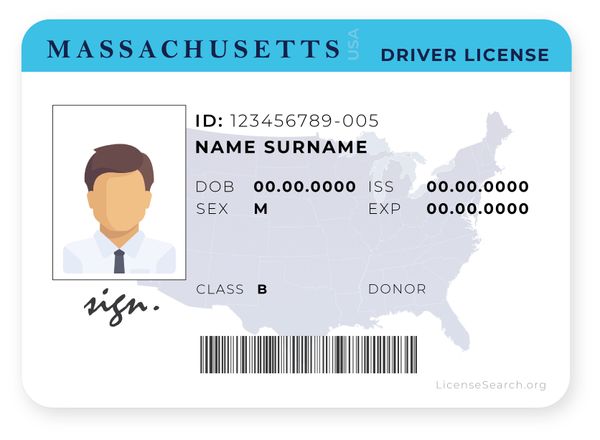
Massachusetts Driver License
In the state of Massachusetts, residents wishing to drive on public roads must obtain a state-issued license before they can legally operate a motor vehicle.
Requirements and steps to obtain a Learner’s permit
A learner’s permit is suitable for those teens, who are at least 16 years old and want to drive in the state of Massachusetts. Actually, the license makes it possible to practice driving being supervised by a licensed adult.
Permit requirements
- To start the process, you should be at least 16 years of age
- Then, you should visit a local RMV office and request an application
- After that, you should fill in the application form and provide current and legit documents
- Not to forget, you should also get the written consent of your parents (or guardian/headmaster), assuring that you can manage and deal with the obligation of driving safely
- The next step is to take both the vision and permit exam (written test)
- Equally important is having your picture taken, as well as signature captured electronically
- Once you successfully pass them, you will need to pay the license fee of $30 and receive the permit
It is important to know that you can choose to have a REAL ID permit or a regular learner’s permit.
Submit the following documents
- Documents of citizenship
- Evidence of lawful presence in the United States (if you do not have citizenship)
- Social Security Number (Social Security Card)
- Residential address in Massachusetts
Driving restrictions
- Not driving between the 12:00 am and 5:00 am if you are under 18 years old (you can only drive being supervised by a parent or legal guardian)
- Always having the learner’s permit with you when you drive
- Not driving a car in another state if the latter does not allow you to
What you need to know about the permit exam
The learner’s permit exam is a major requirement on the way of licensure. Thus, you will need to take and pass it to be eligible for a permit. What comes to the exam, then it is given in multiple-choice format and contains 25 questions. Those questions cover content, such as:
- Alcohol misuse
- Suspensions
- JOL violations
- Driving and road rules
- Road signs
Technically, you will have one minute for each questions and must get at least 18/25 questions right to pass the test.
During the exam, you cannot bring in any types of electronic devices, including headphones, mobiles and so on. In addition to this, you cannot also have with you any helping material, manual or cheating papers.
Steps to get a Junior Operator license in Massachusetts
Teenagers between the ages of 16 1/2 and 18 can apply for a Junior Operator license (JOL), which gives permission to practice unsupervised driving (with some restrictions).
Requirements
- To begin with, you should have your learner’s permit (for at least six months)
- Secondly, you must have a clean driving record
- Thirdly, you must complete a driver education course and obtain helpful knowledge
- You should choose an approved driver education program, which will consist of 30 hours of classroom instruction, as well as 12 hours of in-car, behind-the-wheel training and six hours of in-car experience
- After that, you should practice 40 hours of supervised driving
- A parent or guardian must participate in 2 hours of instruction on the driver’s education course (unless they have completed one within the past 5 years).
- The next step is to schedule a road test, take it and successfully pass the final exam
- You should also bring helping documents, which are listed below
- Finally, you must pay the license fee of $35 and receive the JOL
Bring the following documents
- Road test application
- Your current learner’s permit
Driving restrictions
- You should not carry underage and unrelated passengers without supervision
- Not driving between 12:30 a.m. and 5:00 a.m. (otherwise, you should be driving supervised by a licensed adult). If you do not follow the rules, you will thereby violate the law and be subject to penalties
- Not using any electronic device while driving
- Operating only permitted motor vehicles (for example, not those, which require a commercial driver’s license)
- Not having driving offenses, including alcohol or drugs
How to get a Massachusetts full (adult) driver’s license
You can apply for a full Massachusetts driver’s license providing that you are at least 18 years old and hold your learner’s permit.
Requirements for a driver’s license
- Above all, hold your learner’s permit (at least for six months)
- Secondly, schedule a road test and pass it
- Thirdly, bring the completed road test application and your current learner’s permit with you
- Pay the license fee of $35 and get the driver’s license
Note that you cannot take the road test more than six times within 12 months.
Learn how to replace your Massachusetts driver’s license
In case you have lost your driver’s license or someone has stolen it, you will need to replace it. Therefore, you will need to request a duplicate license and provide your name, date of birth, ID number or the last four digits of your Social Security Number. You will also need to pay $25 as a fee.
If you are serving in the United States Armed Forces, or you are a member of the military personnel, then you can simply send a letter and request a duplicate license. In the letter, you will need to clarify and state whether you lost it or it was stolen. In this case, you will not need to pay as the service is free.
Contact Information
The Driver Licensing Department
Registry of Motor Vehicles
P.O. Box 55889
Boston, MA 02205-5889
Massachusetts driver’s license classifications
Class D
To clarify, this license allows the licensee to operate any single vehicle, such as a passenger vehicle, car, SUVs or family vans/small trucks.
Class A (Commercial)
The license, in short, is for operating any combination of vehicles with a GVWR of 26,001.
Class B (Commercial)
This license, in short, gives permission to operate any single vehicle with a GVWR of 26,001 or more pounds.
Class C (Commercial)
This license, in short, allows the licensee to operate any single vehicle or combination of vehicles, do not meet the definition of Class A or B, and is for transporting 16 (or more) passengers and hazardous materials.
Class M
To clarify, allows operating any motor vehicle defined as a motorcycle.
